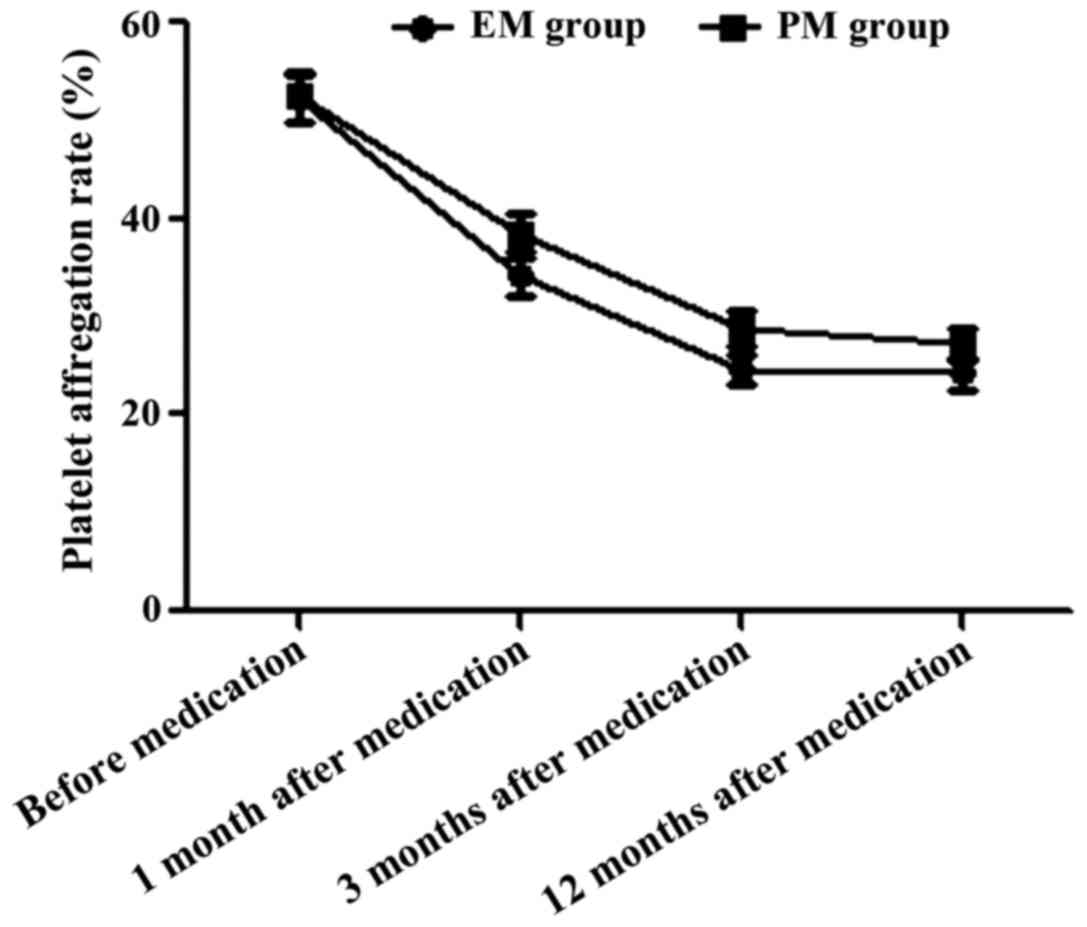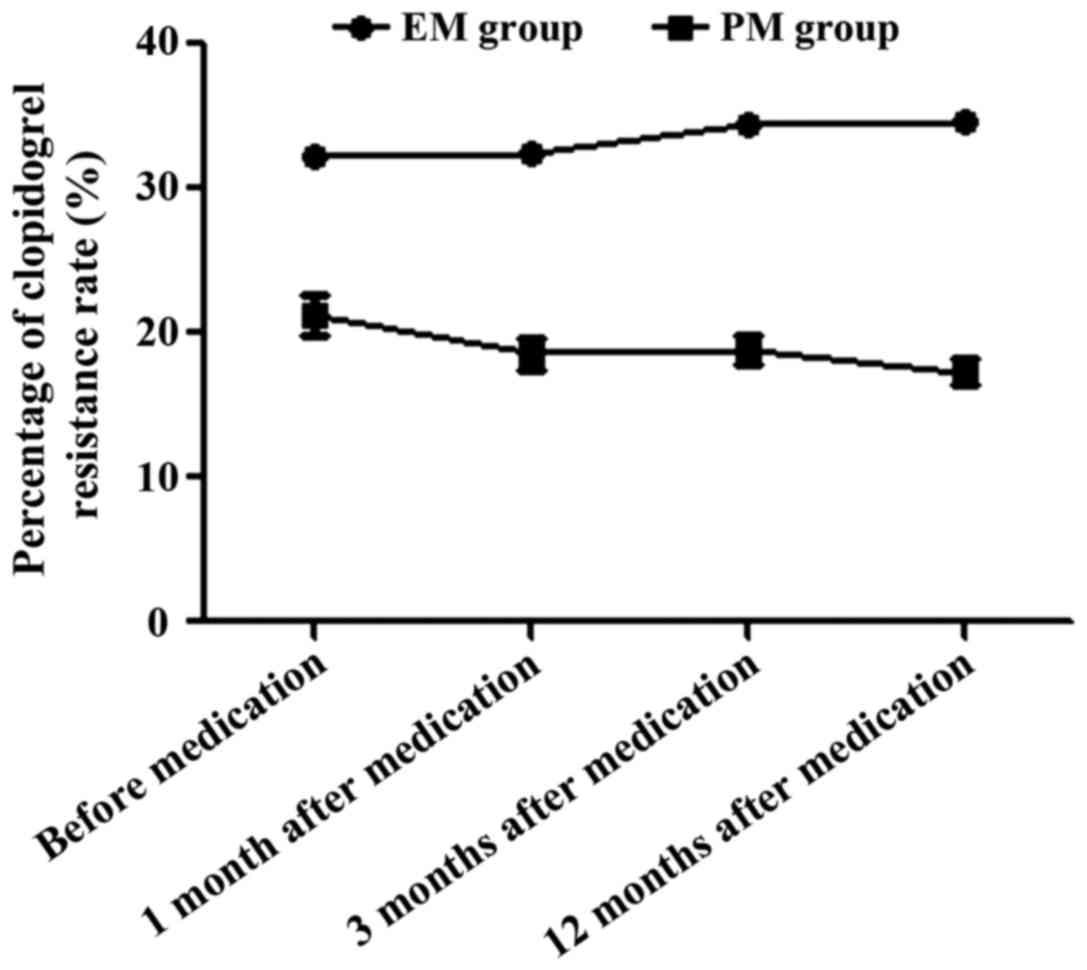|
1
|
Danielak D, Karaźniewicz-Łada M, Komosa A,
Burchardt P, Lesiak M, Kruszyna Ł, Graczyk-Szuster A and Główka F:
Influence of genetic co-factors on the population pharmacokinetic
model for clopidogrel and its active thiol metabolite. Eur J Clin
Pharmacol. 73:1623–1632. 2017. View Article : Google Scholar : PubMed/NCBI
|
|
2
|
Guirgis M, Thompson P and Jansen S: Review
of aspirin and clopidogrel resistance in peripheral arterial
disease. J Vasc Surg. 66:1576–1586. 2017. View Article : Google Scholar : PubMed/NCBI
|
|
3
|
Kagami T, Yamade M, Suzuki T, Uotani T,
Hamaya Y, Iwaizumi M, Osawa S, Sugimoto K, Umemura K, Miyajima H,
et al: Comparative study of effects of vonoprazan and esomeprazole
on anti-platelet function of clopidogrel or prasugrel in relation
to CYP2C19 genotype. Clin Pharmacol Ther. Sep 5–2017.(Epub ahead of
print). PubMed/NCBI
|
|
4
|
Larson EA and Miller NJ:
Point-Counterpoint: CYP2C19 Genotyping for Clopidogrel. S D Med.
70:13–15. 2017.PubMed/NCBI
|
|
5
|
Mirabbasi SA, Khalighi K, Wu Y, Walker S,
Khalighi B, Fan W, Kodali A and Cheng G: CYP2C19 genetic variation
and individualized clopidogrel prescription in a cardiology clinic.
J Community Hosp Intern Med Perspect. 7:151–156. 2017. View Article : Google Scholar : PubMed/NCBI
|
|
6
|
Amin AM, Sheau Chin L, Mohamed Noor DA,
Mostafa H, Abdul Kader MASK, Kah Hay Y and Ibrahim B: The effect of
CYP2C19 genetic polymorphism and non-genetic factors on clopidogrel
platelets inhibition in East Asian coronary artery disease
patients. Thromb Res. 158:22–24. 2017. View Article : Google Scholar : PubMed/NCBI
|
|
7
|
Berinstein E and Levy A: Recent
developments and future directions for the use of pharmacogenomics
in cardiovascular disease treatments. Expert Opin Drug Metab
Toxicol. 13:973–983. 2017. View Article : Google Scholar : PubMed/NCBI
|
|
8
|
Chen S, Zhang Y, Wang L, Geng Y, Gu J, Hao
Q, Wang H and Qi P: Effects of dual-dose clopidogrel, clopidogrel
combined with tongxinluo capsule, and ticagrelor on patients with
coronary heart disease and CYP2C19*2 gene mutation after
percutaneous coronary interventions (PCI). Med Sci Monit.
23:3824–3830. 2017. View Article : Google Scholar : PubMed/NCBI
|
|
9
|
Zhang J, Zhang J, Sun H, Ming T, Liu X,
Cong Y, Li F and Li Z: Association between platelet function and
recurrent ischemic vascular events after TIA and minor stroke. Int
J Clin Pharmacol Ther. 55:789–797. 2017. View Article : Google Scholar : PubMed/NCBI
|
|
10
|
Erathi HV, Durgaprasad R, Velam V, Sarma
PV, Rodda M, Kapil C and Kanavath SN: Evaluation of On-Clopidogrel
platelet reactivity overtime, SYNTAX SCORE, genetic polymorphisms
and their relationship to one year clinical outcomes in STEMI
patients undergoing PCI. Minerva Cardioangiol. 66:16–25.
2018.PubMed/NCBI
|
|
11
|
Borse MS, Dong OM, Polasek MJ, Farley JF,
Stouffer GA and Lee CR: CYP2C19-guided antiplatelet therapy: A
cost-effectiveness analysis of 30-day and 1-year outcomes following
percutaneous coronary intervention. Pharmacogenomics. 18:1155–1166.
2017. View Article : Google Scholar : PubMed/NCBI
|
|
12
|
Tan SSN, Fong AYY, Mejin M, Gerunsin J,
Kong KL, Chin FYY, Tiong LL, Lim MSH, Asri S, Khiew NZ, et al:
Association of CYP2C19*2 polymorphism with clopidogrel response and
1-year major adverse cardiovascular events in a multiethnic
population with drug-eluting stents. Pharmacogenomics.
18:1225–1239. 2017. View Article : Google Scholar : PubMed/NCBI
|
|
13
|
Palacharla RC, Nirogi R, Uthukam V,
Manoharan A, Ponnamaneni RK and Kalaikadhiban I: Quantitative in
vitro phenotyping and prediction of drug interaction potential of
CYP2B6 substrates as victims. Xenobiotica. 28:1–13. 2017.
|
|
14
|
Peng L, Liu J, Qin L, Liu J, Xi S, Lu C
and Yin T: Interaction between platelet-derived microRNAs and
CYP2C19*2 genotype on clopidogrel antiplatelet responsiveness in
patients with ACS. Thromb Res. 157:97–102. 2017. View Article : Google Scholar : PubMed/NCBI
|
|
15
|
Cavallari LH: Personalizing antiplatelet
prescribing using genetics for patients undergoing percutaneous
coronary intervention. Expert Rev Cardiovasc Ther. 15:581–589.
2017. View Article : Google Scholar : PubMed/NCBI
|
|
16
|
Rosafio F, Lelli N, Mimmi S, Vandelli L,
Bigliardi G, Dell'Acqua ML, Picchetto L, Pentore R, Ferraro D,
Trenti T, et al: Platelet function testing in patients with acute
ischemic stroke: An observational study. J Stroke Cerebrovasc Dis.
26:1864–1873. 2017. View Article : Google Scholar : PubMed/NCBI
|
|
17
|
Li J, Wang Y and Wang H: Distribution of
CYP2C19 polymorphisms in Mongolian and Han nationals and the choice
of specific antiplatelet drugs. Int J Clin Pharm. 39:791–797. 2017.
View Article : Google Scholar : PubMed/NCBI
|
|
18
|
Tatarunas V, Kupstyte N, Zaliunas R,
Giedraitiene A and Lesauskaite V: The impact of clinical and
genetic factors on ticagrelor and clopidogrel antiplatelet therapy.
Pharmacogenomics. 18:969–979. 2017. View Article : Google Scholar : PubMed/NCBI
|
|
19
|
Choi YJ, Kim N, Jang IJ, Cho JY, Nam RH,
Park JH, Jo HJ, Yoon H, Shin CM, Park YS, et al: Pantoprazole does
not reduce the antiplatelet effect of clopidogrel: A randomized
controlled trial in Korea. Gut Liver. 11:504–511. 2017. View Article : Google Scholar : PubMed/NCBI
|
|
20
|
Cavallari LH, Weitzel KW, Elsey AR, Liu X,
Mosley SA, Smith DM, Staley BJ, Winterstein AG, Mathews CA, Franchi
F, et al: Institutional profile: University of Florida Health
Personalized Medicine Program. Pharmacogenomics. 18:421–426. 2017.
View Article : Google Scholar : PubMed/NCBI
|











